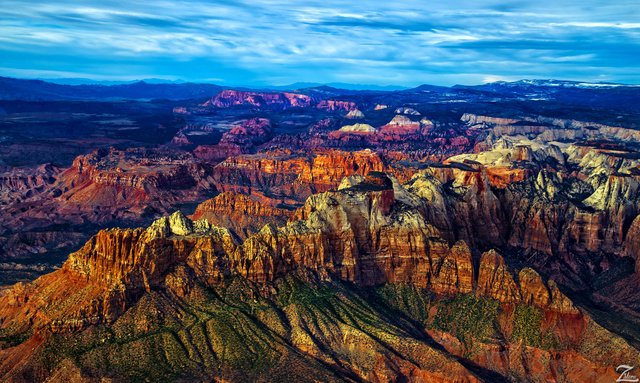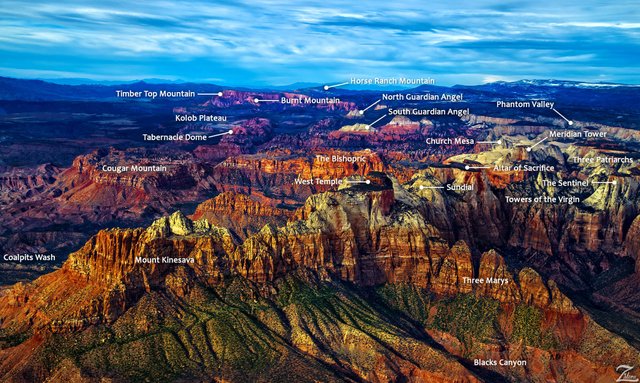One of the Ancient Wonders of the World
On our journey today I bring you to a most remarkable, iconic location that is utterly wondrous to behold, and even more so from this lofty view as seen from Where Eagles Fly… Zion National Park, Utah.
Taken while flying northwest bound across the southern part of the park this very rare image shows the park in its entirety from the south looking north. In the immediate foreground, the large mountainous formation running horizontally across the image is Mount Kinesava and along its top ridge is the Western Temple (in the middle) and the Altar of Sacrifice (to the immediate right of the Western Temple).
Because this is such an iconic location that so many have visited, I created a location map key that details the various famous landmark formations located within the park:
Spread out across the Markagunt and Kolob plateaus, Zion is located at the intersection of three geographic provinces: Colorado Plateau, the Great Basin, and the Mojave Desert.
These otherworldly looking formations are the jagged edge of a huge area that has been twisted, uplifted, tilted, and eroded over time, forming a geological feature known as the Grand Staircase; a series of colorful cliffs stretching up out of the Grand Canyon all the way up to Bryce Canyon and over to Zion National Park. These remarkable geological wonders have formed together over hundreds of millions of years.
The bottom layer of rock at Bryce Canyon is the top layer at Zion, and the bottom layer at Zion is the top layer at the Grand Canyon. Zion began as a flat basin with an elevation near sea level around 240 million years ago. As sands, gravels, and muds eroded from surrounding mountains, these materials ran into the basin and were deposited in layers. Each layer originated from a distinct source and so differs in thickness, mineral content, color, and eroded appearance. In this image you can see the stratified layers clearly along Mount Kinesava across to the Towers of the Virgin.
Then came the upheaval, covering a huge area from Zion all the way over to the Rocky Mountains, forces deep within the earth started to push the surface up in a very slow and relentless vertical hoisting of gigantic blocks of crust. The elevation around Zion rose from near sea level to as high as 10,000 feet above sea level over the course of 240 million years. This uplift force is still happening. In 1992 a magnitude 5.8 earthquake created a landslide outside East Canyon on the south entrance to the park in Springdale.
The lowest point of elevation is 3,666 ft (1,117 m) at Coalpits Wash and the highest is 8,726 ft (2,660 m) at Horse Ranch Mountain. Originally this was known by the First Nations Southern Paiute tribes who lived here as either “Mukuntuweap” which means “straight canyon”, or “ I-oo-gune” or "like an arrow quiver".
In 1909 the President of the United States, William Howard Taft, named the area a National Monument to protect the canyon, under the name of Mukuntuweap National Monument. In 1918, however, the acting director of the newly created National Park Service changed the park's name to Zion, the name used by the Mormons. According to historian Hal Rothman: "The name change played to a prevalent bias of the time. Many believed that Spanish and Indian names would deter visitors who, if they could not pronounce the name of a place, might not bother to visit it. The new name, Zion, had greater appeal to an ethnocentric audience."
The United States Congress established the monument as a National Park on November 19, 1919. I lensed this image while flying northwest over Shunesburg Mountain, south of The Watchmen formation on the southern border of Zion National Park.
This is from my project "Where Eagles Fly - The American Wilderness Expedition" Enjoy!
Yehaw!!


Feels like you live in the Matrix!
Downvoting a post can decrease pending rewards and make it less visible. Common reasons:
Submit
Merci pour cette article très bien fait.
Les photographies sont très intéressants et les montagnes sont impressionnants.
Merci
Cordialement
Downvoting a post can decrease pending rewards and make it less visible. Common reasons:
Submit
this is nice, thank you for sharing! :-)
up-voted
RightWithin
Downvoting a post can decrease pending rewards and make it less visible. Common reasons:
Submit
We must appreciate everything that nature gives us.
Downvoting a post can decrease pending rewards and make it less visible. Common reasons:
Submit
That is one beautiful mountain range right there! Amazing colours!
Downvoting a post can decrease pending rewards and make it less visible. Common reasons:
Submit
I live in utah, and have still never been. This post is inspiring me to get out and see Zion ASAP.
Downvoting a post can decrease pending rewards and make it less visible. Common reasons:
Submit
Beautiful pictures! Keep Steeming!
Downvoting a post can decrease pending rewards and make it less visible. Common reasons:
Submit
this seems to be a pretty great place the pictures are amazing you have a great talent thanks a lot for sharing and keep on posting ;)
Downvoting a post can decrease pending rewards and make it less visible. Common reasons:
Submit
Wow look so great
Downvoting a post can decrease pending rewards and make it less visible. Common reasons:
Submit
you may be interested in my blog)
Downvoting a post can decrease pending rewards and make it less visible. Common reasons:
Submit